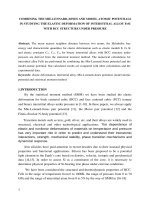The elastic enterprice
Bạn đang xem bản rút gọn của tài liệu. Xem và tải ngay bản đầy đủ của tài liệu tại đây (251.71 KB, 19 trang )
The elastic enterprise:
How flexible working helps you improve efficiency and keep staff happy
Introduction
02
There are some goals a business will never
stop pursuing: finding ways to cut costs, getting
staff to be more motivated, and making the
whole team more productive. And these are the
driving factors behind the growing adoption of
flexible working practices across the UK.
Now hang on a minute – “flexible working”
might sound like the latest bit of business buzzwordery you could live without. But it’s not just
jargon. In fact, it’s probably already happening
in your business. Do you use your phone to
check emails? Do your employees sometimes
work on trains on their way to meetings? Have
you ever let team members leave the office
early to make a personal appointment provided
they make up the time later that week?
Thought so. And these are all examples of
flexible working.
But it can do so much more. Most importantly,
when it’s done right it gives employees the
chance to control their own lives, and it
gives employers better results from more
engaged, longer-serving staff – while cutting
all important costs at the same time. And
that’s not all, in 2010, a review of 10 studies
involving more than 16,000 people found those
who controlled their own working hours were
healthier because they get more rest and are
less stressed. It seems so obvious. So how do
you make it happen in your business? Read on.
Contents
ONE: Hang on a minute – what is flexible working, actually?
TWO: How can flexible working help you do better business?
THREE: Flexible working in practice, a tale of two businesses
FOUR: Ready to become elastic? How to adopt flexible working...
Hang on a minute – what is flexible
working, actually?
ONE
Chap
ter
Hang on a minute – what is flexible
working, actually?
It’s caring about the
quality of the work done, not
how many hours someone is
present in the office. It means
people who need to retreat into
a quiet space to do complicated
work, can. It means we can hire
great people, even if they live
two hours away”
Frank Fenten, director of digital
marketing company, We Love The Web
05
We asked a dozen or so growing small businesses what flexible working meant to them. The answers
were startlingly similar, with one prevailing theme: flexible working is about building trust and loyalty
among staff. It means waving goodbye to the culture of presenteeism and…
Banishing the office
Flexi-time
It’s quite simple – a “virtual office” is a
space providing business owners with payto-use services such as meeting rooms and
photocopiers, a registered business address and
a professional call and mail handling service. So
when you need an office you have one.
For many, this is the biggest win when it comes
to flexible working. Shaking free the 9-5 chains
means measuring output and not input – letting
staff members work the hours that suit them,
when they’re at their most productive.
Extending your business hours
Remote working
Employees can work on the move, from home
and on holiday. It’s about results – not minutes
at a desk.
Flexi-time works both ways. Could you business
benefit from longer trading hours? Are you
looking to expand your business offering to
countries outside your time-zone? Just as
employees benefit from less constrictive
working hours, so too can your customers.
06
We have a man who simply wakes up much earlier
than most – he gets up at 4am. He’s therefore at
work by 7am and that’s incredibly useful to us as he
catches journalists before they even get to their desk.
Anne Cantelo, director of communications company, Onyx
How can flexible working help you
do better business?
TW
O
Cha
pte
r
How can flexible working help you
do better business?
Keep hold of your staff
Better staff engagement and retention is a key
factor cited by businesses that have embraced
flexible working. And a recent survey by the
office specialists, Regus, found that in order to
fit personal and work life into 24 hours, 34% of
employees said they often woke up a lot earlier
or went to bed a lot later than they would wish.
That’s a tired workforce.
For Ervin Cenmurati setting up flexible working
has generated a happier attitude among his
staff. He believes nine out of Directlines’s
body of ten employees would have left if
flexible working wasn’t an option. It’s saved his
business thousands in hiring new staff.
Protect your data
You’ve read the warnings, you know the
dangers, but the likelihood is you’ve not done
much about it. Protecting your business’s data
that is. Yet if your employees use their own
phones to access work emails, or log on to their
emails remotely from home computers, you’re
at risk of data leaks.
08
Staff are happier
and more motivated”
Ervin Cenmurati, Directline Holidays
By rolling out a full flexible working policy, not only
will you be setting your staff up with the equipment
they need to work effectively from, well, anywhere,
but you can implement a full, secure “bring-yourown” programme that ensures your business’s
data is protected across employees’ personal
devices. Two birds, one stone.
Work on the move
Collectively, how many hours does your staff spend
commuting? Transforming this dead time into
valuable output is a no-brainer. By equipping staff
with the right tools – such as smartphones, laptops
and tablets – alongside easy access to the files
and data they need, travel to and from the office,
as well as to meetings and conferences, becomes
time spent being productive. Not frustrated.
How can flexible working help you
do better business?
Stay ahead of the competition
Working flexibly gives your business a huge
advantage over its rivals as it means the
business can adapt and change to focus on
achieving its priorities. A business that allows
its staff to work flexibly using the latest
technologies means they are more likely to be
contactable at unsociable hours, which results
in problems being resolved earlier. Working
flexibly also requires staff to use the latest
tech, which gives staff more advanced tools to
resolve a solution to any problems
Over the long term we expect
to see financial rewards, especially a
reduction in hardware and ongoing
maintenance costs”
O2 on implementing
a bring-you-own device policy
Boost productivity across
your organisation
We’ve had a pretty bad winter and there’s
little to suggest next year’s will be any better.
By providing joined-up, shared access to a
business’s data, not being physically present
due to unforeseen circumstances need not
hinder your business’s productivity.
Cut costs
For many small businesses, the freedom
from overheads like office rent, the capacity
to virtually meet instead of having to travel
to meetings, and the power to attract and
retain committed and hard-working staff,
means flexible working practices significantly
reduces costs.
09
10
We work where, when and how it suits us to
get the job done – whether that’s at home, in
the office, or on the move”
Management Process Systems
Flexible working in practice,
a tale of two businesses
r
e
t
ap
Ch
HREE
T
Flexible working in practice,
a tale of two businesses
Case study ONE
The Big Flexiday
at O2
“In failing to embrace a flexible working
culture, companies are missing out on huge
benefits, both for their business and their staff.”
Said O2 Business Director, Ben Dowd. “Our
own research of over 2,000 UK employees and
over 400 employers shows that three quarters
of people say they are most productive when
they can change when and where they work and
one in ten even rate flexi-working as a more
important benefit than their holiday allowance
and salary.”
And the success of flexiday has since marked
a new era for O2 – from which they’ve not
looked back.
“The changes we’ve seen at O2 since our flexiday speak for themselves, with the right mix of
technology, policy and education, businesses
can use flexible working to help them shape
their own definition of the 9 to 5.”
And it’s not just the output that can be
measured. Since flexible working has been
introduced to the O2 Slough office, the business
is saving £7,000 for every desk no longer
needed, staff are saving a typical 1.5 hours per
day on their commute, and on flexiday itself, 25
tonnes of carbon were saved.
12
Flexible working in practice,
a tale of two businesses
13
Case study TWO
How Tots To Travel grew their business with flexible working
We now operate under a core team of six, each
of whom comes into the office but works part
flexi-time and part remotely. The business
wouldn’t work if everybody was in the same
place at the same hours,” explains Wendy.
From early on Wendy spotted the need for her
company to adopt new technologies to give her
business the flexibility it needed to grow. “One
of the main technologies we use is Skype. We
use it for telephone calls, screen sharing, and
instant messaging. We have colleagues who
work in France for instance, but because we’re
all on Skype we can instant message them and
get everything sorted out very quickly.
Embracing technology has helped to give
her business a more personal touch with
customers too, “by screen sharing we can take
customers through our website and show them
properties that suit them there and then. If they
like the property, we add it to their shortlist,
which we then send to the client straight after
the call. Without screen share we would have
to take notes and send a list of places that we’d
have had to predict the customer might like.
Using screen share helps us to be accurate and
makes the process for the customer quicker.
So what advice would she give to businesses
thinking of going flexi? “ Do it. Becoming
flexible and growing the business is a lot about
getting out and building relationships. If you’re
tied to the office all the time it’s very limiting.
Having good technology gives you the flexibility
to be out visiting suppliers and having meetings
while still being in touch with colleagues and
clients. It gives you the ability to grow your
business.
Ready to become elastic?
How to adopt flexible working...
Ch
FO
UR
apt
e
r
15
“The role of IT is overemphasised. If people simply want to work
different hours or part-time, IT is not needed to support it”
Anne Cantelo, director of
communications company, Onyx
Ready to become elastic?
How to adopt flexible working
So you’re coming round to the idea? Great.
Perhaps you’re already thinking about the
practicalities: which new technologies might
suit whom, which regular meetings could turn
virtual, how much easier it would be to arrange
a conference call rather than travel an extra
hour in rush hour to meet a client.
Well the good news is there’s probably
nothing stopping you from implementing
some new working practices right away.
And the sky’s your limit when it comes to
the possibilities of technology to help you
run your business flexibly.
Here’s your must-have technology
checklist to get you started...
Skype
Despite all the video-conferencing software
packages available, many people still swear by
Skype. After all, it’s free to use, and even your
great-aunt can use it.
A private cloud system or VPN
Whichever you choose, your data must be
readily available and secure. A private cloud
will store your data more securely than a
public one will, and can host everyday office
tools like Word, plus any software as a service
(SaaS) applications you might use.
A virtual private network (VPN), meanwhile,
enables your business’s servers, data and
software to be accessible remotely but hosted
on a central machine – not in the cloud. Do
a little research to find out what suits your
needs best.
16
Ready to become elastic?
How to adopt flexible working
17
Smartphone
Get a web-based data storage service
A strong network
Too obvious? Maybe, but vital nonetheless. A
decent smartphone and tariff is an essential
piece of kit for any flexi business. For Frank
Fenten of We Love The Web it goes even further:
“Skype’s great but you still need a phone, and a
talk-until-your-hind-legs-fall-off tariff should be
part of the any standard toolkit.”
Simultaneously work on a document with your
colleagues in real time from the opposites
sides of the world. Or Birmingham. Wherever
you are, the technology offered by these types
of businesses is a revolution in collaborative
working. Search online for the best.
Fast and powerful Internet is vital. Whether
it’s 3g, 4g or Wifi, you need to make sure your
business is as Internet ready as possible. You
want to be able to take full advantage of any
new technologies, which allows your business
to work flexibly which makes powerful Internet
a must for this. For example a bad connection
that results in important Skype calls with a
customer cutting out would be terrible.
Instant Messaging
Tablets
Being able to carry around a sleek tablet that
houses all of your documents is a huge plus.
Type your notes on it in meetings and instantly
sync these notes with your other devices. Show
examples of your website, products or other
offerings in an easy smart way, without having
to plug in a laptop and wait while you load up all
the work you need.
Whether it’s Skype, Chatter or Apple’s Instant
Messenger (IM), for many businesses this easy
and immediate way of communicating is faster
and more effective than traditional email. It can
be pretty fun too…
How to measure output
rather than time
Set targets
These need not be numerically quantifiable, but should be drawn up as a
collaborative process with your employee. Discuss the targets, agree to
them and keep a record. Review them regularly – at least once a month.
Communicate
While you get used to this new way of working it’s better to overcommunicate than to under-communicate. You’ll need to check in with
your team on a regular basis – but be careful, you’re checking in not up.
Weekly round-ups
Ask each team member to provide weekly bullet-pointed round-ups
of what they’re working on and the progress they’ve made. Ask them
to share this update with the rest of the team and keep it somewhere
accessible to all. Every two months review the updates.
18





